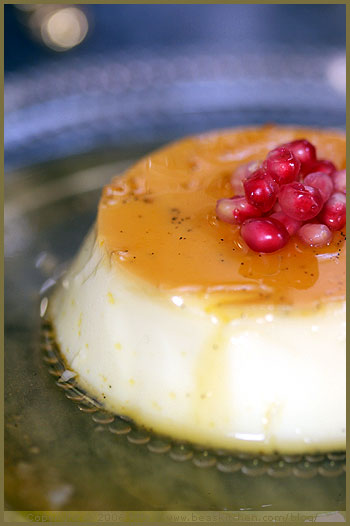
I learned something interesting. J’en suis renversée ! I am amazed by it! Yes, just like la crème (like the cream). Whenever you make caramel, you only need one thing, or maybe two.
For my second time, I got it right. Finally! La seconde fois était la bonne ! (The second time was the good one!) I even know why the caramel I tried to make did not work so well the first time. Typical actually of me, and partially attributed to a shortcoming I have lived with for most of my life, le manque de patience. Lack of patience! In fact, I realized that not only I used the wrong type of sugar to make the caramel, but I also simply did not wait for the time the sugar needs to transform itself in a beautifully colored caramel.
So I tried a second time, and a third to make sure, and was pleased to see that the results were excellent.
La crème renversée
It is sometimes the simplest things that are the most rewarding. For most French people, a crème renversée is nothing extraordinary in view of the possible choices of desserts. A crème renversée can be eaten in most traditional French restaurants, to the point that making it at home is not going to be a real call from the heart pour la ménagère française (for the French housewife). Things are however different for me. I believe that when you do not have easy access to a certain dish you like, you start missing it, and so having and making it becomes a special occasion. Créer le manque (missing something) can be a good thing. Because there are not many places where I live where I can find crème renversée, my only other option is to make it at home. I have actually learned to appreciate this dessert more because, as it is difficult to find, I miss it so much. Try to understand the logical reasoning behind this and apply the theory to many things, and you will see it works.
For the longest time, I assumed that crème renversée and crème caramel were the same thing. Can you see the difference in the two desserts when there is seemingly none? To me, these two desserts are so close that perhaps if I were to have one of each in front of me, I would not know which one is which. They both belong to the family of what we call in French, les entremets, preparations made of milk, eggs and sugar, served cold. Both a crème caramel and a crème renversée will be cooked in a bain-marie, and take their final shape from a mold in which the preparation is poured. They are then flipped on a plate. A crème renversée can be done without caramel whereas a crème caramel will have caramel, obviously. Looking at different recipes, I realized about a small difference: whereas the first dessert uses a combination of egg yolks with whole eggs, the second one uses whole eggs. So as to be able to decide which texture I preferred, I ran a series of tests by which I cooked the cream at different oven temperatures: 275 F the first time and 350 F the second time. The results were clear: I strongly favored the texture when cooking the cream in a low-temperature oven. Of course, when doing so, it required twice as long to cook.
Because the verb renverser in French really means to turn over, you will understand why this dessert is called une crème renversée. There is no secret as it is precisely what you do when you unmold the cream: turn the cream over on a plate. As soon as you do so, a pool of shiny yellow caramel falls down on the plate as it is released from the bottom of the mold. Simplement irrésistible ! Simply irresistible! Just for the fun of seeing this caramel run, I would make crème renversée or crème caramel over and over.
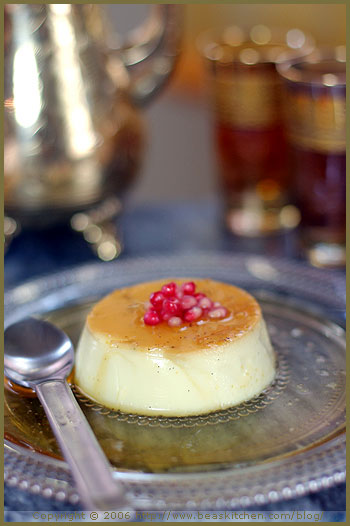
I should maybe also add that I have always been attracted to desserts of the flan type. Eggs, milk, sugar, can we get a more simple combination? Choosing between a crème brûlée, crema catalana, crème caramel, or a crème renversée? What a challenging decision to make!
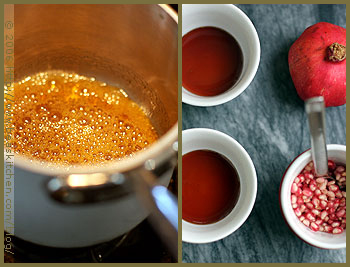
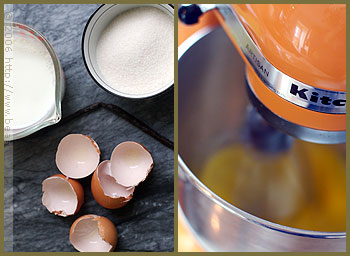
Following the steps of this recipe are really simple. Mixing the eggs with the sugar is effortless. Such is adding milk. I advise to remember to remove the foam which forms at the surface of the cream, after you beat the eggs with the sugar and milk. It really helps to achieve a smooth texture of the cream, once it is cooked.
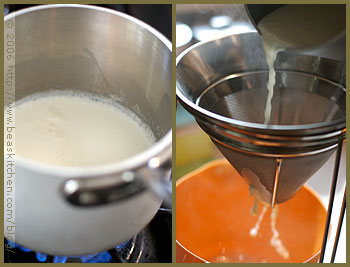
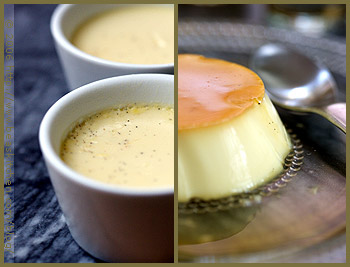
And so, with this being said, I just advise you to try. Whenever I go back to France, I am always reminded how much we love desserts of this kind. Next time you are in France, take a walk into the simplest supermarket and check the cold section, where yogurts, cream and fresh fromage blanc are kept. You will understand what I mean, with your own eyes. Les crèmes desserts, what a world of happiness!
You need:
For the Caramel:
- 5.5 oz fine white sugar
- 3 Tbsp + 1 tsp water
- 1 Tbsp warm water
Steps:
- Put the sugar and water in a small pot. Once the sugar has absorbed the water, bring to a boil. The caramel is ready when it has a nice golden color. You do not need to stir often (it takes about 8 to 10 mns).
- Add 1 Tbsp warm water and stir quickly.
- Pour the caramel in oiled ramekins without waiting. Set on the side.
For the Vanilla Cream:
- 2 cups + 3 Tbsp whole milk
- 1 vanilla bean, open and seeds removed
- 3 large eggs
- 2 large egg yolks
- 2.7 oz fine sugar
Steps:
- Boil the milk with the vanilla bean. Cover and let infuse for 30 mns before filtering the milk.
- Make your caramel and pour it in the oiled ramekins.
- Beat the eggs with the sugar for 1 mn using a stand mixer, if you have one.
- Pour the hot milk on the egg/sugar preparation and mix well.
- Let the preparation rest for a few minutes, before removing the foam that formed at the surface (with a spoon).
- Divide the cream between the ramekins and place them in an rimmed oven dish.
- Cover with a sheet of foil paper.
- Pour water in the dish, as high as half of the height of the ramekins (making a bain-marie).
- Cook in a preheated oven at 275 F, for about 1 hour.
- Make sure the creams are cooked by inserting the blade of a knife in the middle. If it comes out dry, the creams are ready. Remove them and let them cool down. Cover each with a sheet of plastic film, and place them in the fridge.
- To unmold them easily, dip the molds in boiling water for 1 or 2 mns so that the caramel is less solid. Run the blade of a knife between the cream and the ramekin edge. Turn them over on a plate. Decorate with fresh fruit such as pomegrenate or fresh raspberries. This gives a nice colorful touch to your dessert.
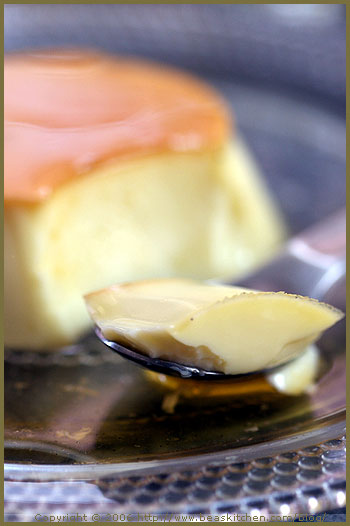
Pour le caramel :
- 150 g de sucre blanc fin
- 50 ml d’eau
- 1 càs d’eau chaude
Étapes :
- Mettez le sucre et l’eau dans une casserole. Une fois le sucre imbibé, amenez à ébullition. Il n’est pas nécessaire de remuer souvent. Le caramel est prêt quand il a une belle couleur ambrée (après 8 à 10 mns).
- Ajoutez 1 càs d’eau chaude et remuez rapidement.
- Versez le caramel dans des ramequins huilés sans attendre. Mettez-les de côté.
Pour la crème prise à la vanille :
- 500 ml de lait entier
- 1 gousse de vanille fendue et grattée
- 3 oeufs
- 2 jaunes d’oeuf
- 75 g de sucre
Étapes :
- Faites bouillir le lait avec la gousse de vanille fendue. Laissez infuser à couvert pendant 30 mns. Filtrez le lait.
- Réalisez votre caramel et versez-le dans des ramequins huilés.
- Mélangez les oeufs avec le sucre pendant 1 mn, au batteur.
- Versez le lait chaud sur le mélange sucre/oeufs et mélangez bien.
- Laissez la préparation reposer quelques minutes avant d’enlever l’écume à la surface (avec une cuiller).
- Répartissez la crème entre les ramequins et mettez-les dans un plat à rebord allant au four.
- Couvrez-les avec une feuille de papier aluminium.
- Versez de l’eau dans le plat, à mi-hauteur des ramequins, pour réaliser un bain-marie.
- Faites cuire au four préchauffé à 140 C pendant environ 1 heure.
- Vérifiez que les crèmes sont cuites en insérant la lame d’un couteau au centre. Si la lame ressort sèche, elles sont cuites. Sortez-les alors du four, et laissez-les refroidir avant de les mettre au frigidaire (recouvertes d’un film alimentaire).
- Pour les démouler facilement, trempez-les pendant 1 à 2 mns dans de l’eau bouillante et passez la lame d’un couteau entre la crème et le bord du ramequin. Renversez-les sur des assiettes. Servez avec des fruits frais, comme de la grenade ou des framboises. C’est une jolie touche de couleur.

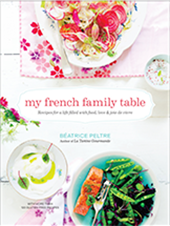
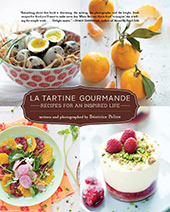
je suis une fana des crèmes qu’elles soient brûlées, catalanes ou renversées.. et ta dernière photo m’achève!!!
J’en suis…renversée!! Delicieuses photos avec graines de vanille bien apparentes et la petite touche “grenade”…mmm je retombe dans mon enfance!
completely amazed and “upside down”!!!
Looks heavenly…yes patience is the key to good caramel.
I bought ramekins and a blowtorch yesterday in the hopes of making a creme brulee…but since finding out that the blowtorch is faulty, I’ve been ever so depressed.
I might give this gorgeous dessert of yours a try and see whether it will lift my spirits 🙂
Ahh, it looks so perfect and delicious!! And what a nice post–so informative. The pictures are amazing–how do you manage to cook and take the pictures? And I think I’m going to book a flight, just so I can go check out the lovely creme desserts in France! 🙂 And then I’ll check out the cheese…and then…
Wow, this looks so delicious. I wish I could have just one or two. So simple and yet so elegant!
Dianka!
I really need a coolio macro lens…I love your depth of field 🙂
It looks nice with the caramel and I’m jealous that you have the Artisan Kitchen Aid 🙂
I remember eating many a creme renversee when I was in France, but it is not something I’ve attempted at home. Yours looks super!
How beautiful (as always)…this sweet looks like heaven.
j
J’ai fait des crèmes brulées lundi midi pour la première fois depuis longtemps et c’était très bon. Dans l’une d’elle j’ai mis quelques grains de café soluble sur le dessus, délicieux.
Ma crème avait de petites bulles, normal, j’avais mis la foam du batteur 🙂
Toujours aussi belles photos, j’admire.
hmmm…I love creme caramel. Yours is esp. lovely!
Hi Bea
I’m a big fan of your site. I’ve tagged you for the 5 things to eat before you die …(am still a bit new to all this). Hope that’s ok..
J’adore ces petites crèmes.
This is quite similar to Filipino custard- leche flan. It has to be my favourite out of all the custards.
I love how you included photos of the different steps you took. How very diligent of you Bea!
Comme d’hab les photos sont à tomber!!!!! J’ai fait récemment des crèmes au citron (même principe que la crème brûlée, passe me voir sur mon blog!).
je me suis délectée de a à z en te lisant… étape après étape de ta présentation de ce dessert ultra classique jusqu’à la dernière photo qui, comme Avital, m’achève dès le matin… c’est bon de ressentir le manque quand on peut ainsi le combler, pas de doute!
It’s funny because in most countries, including Mexico where it may have been invented, ‘flan’ is an upside-down caramelized custard. But in France, ‘flan’ (or ‘far’) is something different, and far (no pun intended) richer.
Either one…j’adore!
je suis comme toi : j’adore ce dessert si douillet!
Superbe j’adore ça et j’en ai jamais fait moi même…
Merci donc pour cette belle recette, et pour ce reportage photo très détaillé, j’aime beaucoup 🙂
splendide post!!
dimanche matin elle sera mon boulot…
très bonne journée
Oh làlà, voilà une recette de plus à tester! Mmmhhh, ça m’a l’air vraiment délicieux! Et tes photos sont toujours aussi magnifiques! Bravo!
moi j’ai tt de mm une question… mais comment fais-tu pr garder un tour de taille acceptable avec ces delices que tu ns mets sous le nez chaque jours ??!!
Continue Bea !!! J’adore consulter ton blog !
Corinne
It looks every bit perfect! Stunning!
That lead photo is fabulous — sumptuous and seductive. Should be a book cover!!
Comme disait Noemie plus haut, tu nous fais retomber en enfance, mais avec classe!
Stunning photos, Bea! I can sympathize with your lack of patience – as I can be like that too, particularly when preparing something new and exciting! However, it looks like you have this treat perfected!
that first shot is to die for and thanks for such a wonderful write-up on creme caramel / creme renversee – and psst, guess what, I just learned from reading your post that one is supposed to oil the ramekins before pouring in the caramel (no wonder my caramel always stick horrendously to the ramekin’s bottoms)! thanks 🙂
aahh..i just did this for my daughter’s bday dinner recently…have you ever heard of leche flan? this is how we normally make the caramel for the flan…perfect bea!
et bien tu vois qu’il fallait perséverer ! superbe
je comprends pas grand chose, mais je craque !.. c’est trop beau
OMG! I did pommies today too :O
I’ll add a link to your recipe Bea when I get home. Great minds etc. 🙂
A tomber ! Et les photos sont superbes.
What a gorgeous dessert you’ve dreamed up, Bea! Love the shot of the cooking caramel!
Oh la la, je fais un petit tour rapide sur les blogs, et je suis tombée en arrêt devant ta sublime première photo ! Les autres aussi sont à tomber… Sans parler du dessert en lui-même !
I love your garnish of pomegranate seeds–like a little bit of jewelry for the humble creme.
A simple (or look simple) dish is definitely not simple to make! You just did an excellent job! Bea, do you use a new len? I see the effect of these photos is very different. Superb!
Thanks a lot all for your comments. Merci à tous pour vos commentaires. I am definitely perfecting it. I should not admit it, but I keep making more, over and over. 😉 It is SO good!
Gattina, no new lens, no, but I wish! I have a LONG list of lenses I would like 😉
These are so delicate looking, yet inviting. Great photos too, Bea!
c’était évident que tu y arriverais! 🙂
elle est vraiment superbe ta crème! quel bonheur de manger une pareille crème!!
congratulations on making the caramel work. i will admit it’s the reason for my hesitation of ever making this dessert but i’m glad to know that it’s easily solveable. beautiful as ever, i think i’m having quite a craving.
Oh I love your blog, and since I started reading it, my family started to see me more in the kitchen trying new recipes. If you are attracted to flan type desserts, you will love the Brazilian flan, and you can use the caramel from your crème renversée which is common practice here with our flan. The recipe is on my blog. Enjoy your time in beautiful France. Regards from Brazil.
My French MIL makes a crème renversée to die for. It’s really not like crème caramel. It’s always well received when presented for dessert and she finally shared a few secrets of how to make extra onctieuse (thick and creamy).
Pingback: La Tartine Gourmande » Blog Archive » Favorites 2006 — Favoris 2006
Pingback: Coconut Forever — Noix de coco pour toujours by La Tartine Gourmande
Pingback: Tapioca Pudding — Pudding au tapioca | La Tartine Gourmande
Pingback: Yummy French Kids’ School Lunches…this week in the heart of Provence « Karen Le Billon
Hi!
Thank you for this awesome blog! Delicious from the recipes to the photos!
I had a question on this recipe:
I respected the recipe and it’s been one hour I cooked the flan in the preheated oven at 275 but the flan in bain marie covered by foil is still liquid. Why is that?
Thank you 🙂
Hi cm,
Not sure what could have gone wrong. Was the preparation hot when you poured it in the ramekins? It definitely sets (although still moving a bit when jiggled). It completely sets in the fridge then. I hope it turns out well for you.
Can one make crème renversee with soy milk?
I have not tried before, so I would not be affirmative before having tried myself.
hi! what size ramekins did you use? thank you!